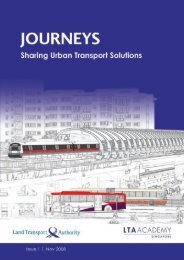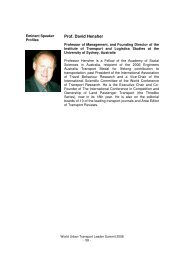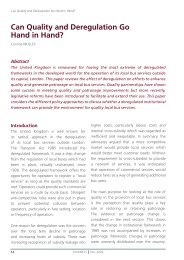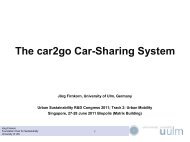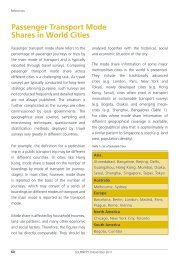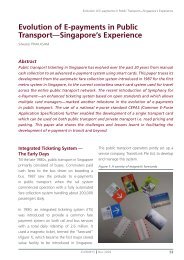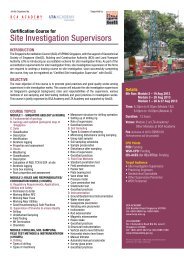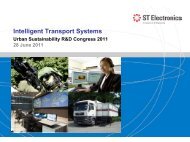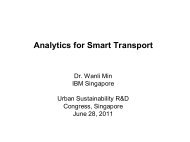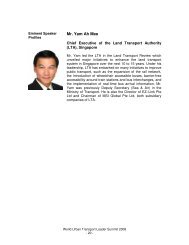Full Version - Issue 7 | November 2011 - LTA Academy
Full Version - Issue 7 | November 2011 - LTA Academy
Full Version - Issue 7 | November 2011 - LTA Academy
Create successful ePaper yourself
Turn your PDF publications into a flip-book with our unique Google optimized e-Paper software.
Urban Sustainability and Transportation: Research Framework for Medium and Long Term Transport Planning<br />
Previous work has served to highlight the<br />
shortcomings and issues, but has not yet<br />
integrated the proposed solutions into a<br />
working system, which is the only way to<br />
verify if the parts work together or if other<br />
solutions have to be found.<br />
The description of the alternatives will<br />
include the usual variables: attributes of<br />
the apartment, accessibility, etc., for the<br />
case of residential location choice, and<br />
generalised cost elements for the given<br />
schedule (including parking variables), store<br />
size brand name, etc., for the activity and<br />
firm location choice. However, to address<br />
the issues of choice set size but also to take<br />
advantage of new available data sources,<br />
the description of the alternatives will have<br />
to be enriched by further elements, such<br />
as, capacity effects, quality of service, price<br />
levels, target markets and brand visibility.<br />
A further strategy to control the size and<br />
actual relevance of the choice set will be<br />
based on existing approaches (Horni et al.<br />
2009, and Scott 2006), to incorporate the<br />
time-space constraints of the schedules<br />
(Hägerstrand 1970). Those approaches<br />
have improved the performance of the<br />
choice models. However, since they still lack<br />
a coherent way to estimate the appropriate<br />
endogenous size of the time-space prisms,<br />
the research will particularly focus on this<br />
problem.<br />
The incorporation of social networks and<br />
analysis of its impact to location choice<br />
problems is a further aspect of the research<br />
and described later in this article.<br />
JOURNEYS | <strong>November</strong> <strong>2011</strong><br />
The construction of the very large<br />
choice sets is still computationally<br />
very expensive and, therefore, often<br />
not properly addressed. Previous<br />
work has served to highlight the<br />
shortcomings and issues, but has not<br />
yet integrated the proposed solutions<br />
into a working system,<br />
• Service Provider Agents<br />
The agent-based models do not model the<br />
choices of the suppliers of these services,<br />
so-called service provider agents, i.e.,<br />
retailers, car sharing companies, restaurant<br />
chains, banks, etc. For a long-term model<br />
of land use and transport at the parcel level,<br />
it is not possible to ignore the moves of the<br />
firms in response to transport and land use<br />
policies.<br />
The design of the agents will be developed<br />
based on a review of the existing<br />
literature about the strategies of the<br />
service providers, so that the scope of the<br />
capabilities is both realistic and appropriate.<br />
In case of retailers, the project can draw<br />
on initial work undertaken at ETH, where<br />
detailed interviews of retailers (Löchl<br />
2010) were undertaken (Arentze and<br />
Timmermans 2007). The design phase will<br />
specify the internal model of agents, which<br />
will be used to adapt their network of<br />
locations, capacities and service/price levels.<br />
While formal optimisation techniques are a<br />
possibility, the preferred approach at this<br />
time is, for example, a guided adaptation<br />
(Ciardi et al. 2008).<br />
13



